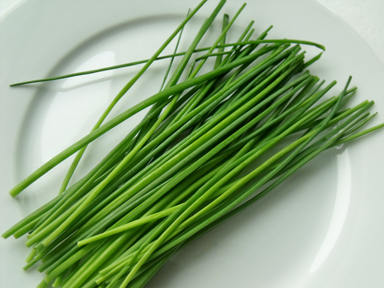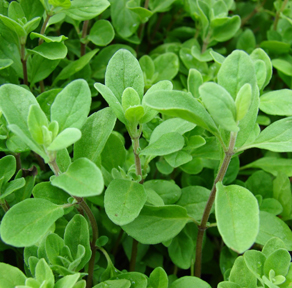Growing Herbs
Easy and Tasty
Basil
Basil likes the warmth of full sun to grow best. Lift transplants carefully by the leaves instead of the stem. Set outdoors only after soil and air temperatures are warm. One chilly night can set plants back. Sweet green basil can be dried, frozen in ice cubes, or used fresh. Blended with pine nuts, oil and cheese, this basil is the prime ingredient in pesto. It is also good for making flavored vinegar for salad dressing, or suffused in oil for flavored oil. Purple basil is best used fresh in salads, and for making flavored vinegar. In the garden, purple basil is a colorful contrast to annual flowers, and its color is useful in cut arrangements.
Chives
There are several forms of chives, but the most common one has roundish leaves that are used for their onion-like flavor. This perennial is hardy to Zone 3. In spring, it has lovely purple flowers made up of masses of florets. Chives like full sun and rich soil. They can take partial shade, but will not grow as fully erect. The leaves will die back in the summer heat, but may return in the fall. Clumps should last four to five years before dividing. Chives can be harvested for fresh use in salads and recipes. Cut a few leaves to the base, but don’t shear the whole plant down to the base or they won’t be able to manufacture food for the roots. The flower heads can be used to make chive vinegar, and the flowers can also be dried. To dry the flowers, put them in a paper bag, but leave the mouth of the bag open. Don’t tie the stems together or they may rot instead of dry. Chives can be dried by snipping the leaves as you would for a salad, and then placing them on a fine screen or nylon mesh in a warm place, out of direct light. Stir regularly for several days. When dry, seal in jars.
Lemon Verbena
Lemon verbena is a tender perennial that is best purchased as a growing plant. In the garden it needs full sun and temperatures above 65 degrees F for best growth. Lemon verbena leaves can add a fresh flavor to fruit salads or beverages, but they are best removed before serving because the leaves are very difficult to chew. The leaves can be dried by placing them on a screen or mesh in a warm place out of bright light. The dried leaves can be used to make a tea.
Oregano
Origanum vulgare and its cultivars are the familiar forms of oregano. This is a perennial hardy to Zone 5. Transplant to the garden in full sun. Oregano is used in a wide variety of cooking, in addition to sprinkling it on salads and pizzas. Oregano can be used fresh, but is most often dried. To dry, cut the stems to the base just as the plants come into flower. Place tips down in a paper bag. Tie the bag around the stems and hang in a warm place. Check for drying after two or three weeks by rubbing the bag between your hands. If you hear leaves falling to the bottom of the bag, it is ready to be opened. Strip the leaves off the stems and finish drying in a 100-degree oven, checking frequently. Let cool, and then run the leaves through a coarse screen before bottling. If saving whole leaves, be sure to remove any bits of stem.
Parsley
Once in the sunny garden, parsley responds well to a weak fertilizer every two weeks or so. This is especially important if it is cut frequently. Parsley is frequently used as a decorative addition to a plate of food, and it is a tangy addition to salads. When de-stemmed leaves are chopped in a blender with a little water (pack a 2 cup measuring cup with leaves, then fill with water), they can be frozen into ice cubes for later use. Parsley also makes a decorative hanging basket or pot, whether or not it is planned for eating. The green leaves can be dried quickly when spread on a cookie sheet and “cooked” at 400 degrees F for about 15 minutes. Stir every 5 minutes and do not let it burn, just crisp. Crumble the crisp leaves, remove any limp bits, allow to cool, then store in a tightly closed jar. Parsley does not dry well by hanging.
Rosemary
Rosemary comes in many cultivars, and the same cultivar grown on the West Coast may look very different when grown in the Midwest. It is a perennial, hardy to Zone 8; and since seedlings can take months, it is best purchased as a potted plant for most home gardens. Outdoors it likes full sun, and can be kept on the dry side. The pungent, curved needle-like leaves have many uses. It is easily dried by hanging woody stemmed bunches in a warm place. The leaves can then be stripped off and bottled. Rosemary is a very pungent herb, and it is best used sparingly on bland foods. In cooking, it is frequently used with chicken, and in baking, such as in breads.
Sweet Marjoram
This is a tender perennial best grown as an annual in most parts of the U.S. It is hardy to Zone 10. A member of the oregano family, sweet marjoram and oregano are often confused, but their flavors are different. Place plants in full sun in a well-drained location.
Once established, leaves should be taken randomly rather than shearing the growing tips. When frost time nears, plants can be potted up and taken indoors for a few months. Sweet marjoram dries easily on screens in the shade. Once dried, finish the drying in a 100 degree F or lower temperature oven to crisp the leaves. Remove leaves from the stems and store in jars. Sweet marjoram can be used fresh in omelets, mixed with fresh vegetables, and added to casseroles.
Common Thyme
Thyme, a perennial hardy to Zone 4, can be grown from seed in a flat kept at about 55 degrees F. Germination takes three to four weeks. The first year plants will be small and not flower, growing more robust and flowering the second year. Thyme needs good drainage for its deep roots. Plants should not be set too close together (12 inches apart), and should be hardened off before planting in the garden (a week or more of several hours of sunlight and then returned to shade before evening). Dry thyme by hanging bunches in a warm place out of direct sunlight. Thyme is frequently used fresh or dried in soups, stews and sauces. Fresh thyme added to rice is a flavorful treat. Lemon-scented thymes are good for tea and potpourri.
Source: National Garden Bureau, ngb.org








